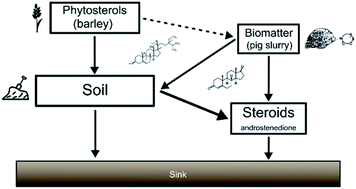We propose a conceptual model that describes the in situ formation of androstenedione in agricultural soil from a phytosterol, β-sitosterol, released after crop harvest and soil fertiliser amendment. Based on the recorded agricultural practice at a spring barley field, β-sitosterol and androstenedione concentrations were modelled over the year. While decomposition of crop residues created low soil levels, the application of pig slurry led to an androstenedione soil concentration of 54 μg kg−1. The elevated soil concentration of androstenedione is not due to the introduction of the endocrine disruptor in the fertiliser, but a result of the addition of large concentrations of β-sitosterol as a natural precursor. The limited available data on β-sitosterol and androstenedione concentration in soil prohibited their accurate prediction by our model. However, the potential implication of endocrine-disrupting steroid hormones being formed in situ from currently little considered phytosterols justifies a conceptual description and further research.

